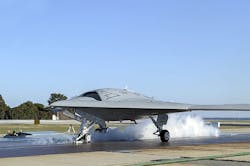U.S. Navy, Northrop Grumman log first X-47B UCAS catapult launch, rely on modeling, simulation, and flight software validation
PATUXENT RIVER, Md., 30 Nov. 2012. The X-47BUnmanned Combat Air System (UCAS) demonstrator completed its inaugural land-based catapult launch at Naval Air Systems Command in Patuxent River, Md., on 29 Nov.
The Navy's first-ever steam catapult launch of the pilotless X-47B unmanned aerial vehicle (UAV) helps to ensure the vehicle structure can withstand the rigors of the stringent aircraft-carrier environment.
Will this event trigger a new era for naval aviation? Navy officials believe so.
"The X-47B shore-based catapult launch we witnessed here will leave a mark in history," says Vice Adm. David Dunaway, NAVAIR commander. "We are working toward the future integration of unmanned aircraft on the carrier deck, something we didn't envision 60 years ago when the steam catapult was first built here."
Naval aviation engineers have long relied on experienced test pilots to help evaluate aircraft flying qualities and structural suitability. The Navy UCAS integrated test team relied solely on data from a pre-programmed automated X-47B aircraft.
"Carrier-based unmanned aircraft will change the concept of operations for the carrier-controlled airspace," says Rear Adm. Mat Winter, program executive officer for unmanned aviation and strike weapons. "The N-UCAS program's goal is to demonstrate integration of an unmanned aircraft into a carrier environment and reduce technical risk associated with developing potential future unmanned, carrier-compatible systems."
Extensive modeling and simulation was performed prior to the demonstration, giving the team “great confidence in the X-47B's ability to operate on the flight deck," explains Capt. Jaime Engdahl, the Navy UCAS program manager.
The combined Navy and Northrop Grumman team will continue ground-based catapult verification and final flight software validation at Pax River before embarking on USS Harry S. Truman (CVN 75) later this month for initial sea trials.
"We are breaking new ground with the development of a carrier-based system that enables launch and recovery support of an unmanned platform off a carrier flight deck," Engdahl says. "Every test we are conducting at Pax River and at sea is a historic milestone for naval aviation."
The Navy will use the X-47B to demonstrate the first carrier-based launches and recoveries by an autonomous, unmanned aircraft in 2013.
Follow Avionics Intelligence news updates on Twitter (@Avionics_Intel), LinkedIn, and Google+.
